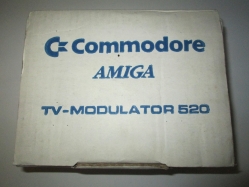
Autopsy:
The Commodore Amiga 520 Video Adapter is a device that allows you to connect your Amiga 500 to a TV set or a composite video monitor.
It does this by converting the RGB video signal the Amiga produces for RGB monitors to a composite video signal that a TV or composite monitor can interpret.
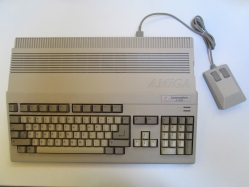
Autopsy:
from Wikipedia:
The Amiga 500 – also known as the A500 (or its code name ‘Rock Lobster’) – was the first “low-end” Commodore Amiga 16/32-bit multimedia home/personal computer. It was announced at the winter Consumer Electronics Show in January 1987 – at the same time as the high-end Amiga 2000 – and competed directly against the Atari 520ST. Before Amiga 500 was shipped, Commodore suggested that the list price of the Amiga 500 was 595.95 USD without a monitor. At delivery in 1987, Commodore announced that the Amiga 500 would carry a 699 USD list price.
The Amiga 500 represented a return to Commodore’s roots by being sold in the same mass retail outlets as the Commodore 64 – to which it was a spiritual successor – as opposed to the computer-store-only Amiga 1000.
The original Amiga 500 proved to be Commodore’s best-selling Amiga model, enjoying particular success in Europe. Although popular with hobbyists, arguably its most widespread use was as a gaming machine, where its advanced graphics and sound for the time were of significant benefit.
The Amiga 500 series was discontinued in mid-1992 replaced by the similarly specified and priced Amiga 600, although this new machine had originally been intended as a much cheaper budget model, which would have been the A300. In late 1992, Commodore released the “next-generation” Amiga 1200, a machine closer in concept to the original Amiga 500, but featuring significant technical improvements. Despite this, neither the A1200 nor the A600 replicated the commercial success of its predecessor as, by this time, the market was definitively shifting from the home computer platforms of the past to commodity Wintel PCs and the new “low-cost” Macintosh Classic, LC and IIsi models.
source: wikipedia
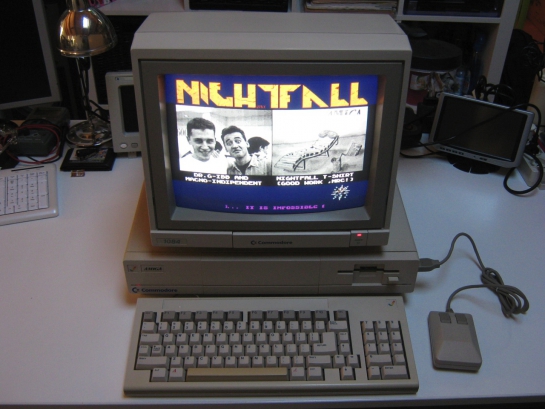
Autopsy:
Many years have passed since i sold my Amiga 1000 with Memory Expansion and Harddisk but with some patience and thanks to a friend i have found an Amiga 1000 in good condition for my RetroComputer museum.
As you can see from the photos i have changed the yellowed keyboard cover with a new one that was sold many years ago for Commodore spare parts.
from Wikipedia:
The A1000, or Commodore Amiga 1000, was Commodore’s initial Amiga personal computer, introduced on July 23, 1985 at the Lincoln Center in New York City. Machines began shipping in September with a base configuration of 256 kB of RAM at the retail price of 1,295 USD. A 13-inch (330 mm) analog RGB monitor was available for around 300 USD bringing the price of a complete Amiga system to 1,595 USD. Before the release of the Amiga 500 and A2000 models in 1987, the A1000 was simply called Amiga.
In the US, the A1000 was marketed as The Amiga from Commodore, however the Commodore logo was omitted from the casing. Additionally the Amiga 1000 was exclusively sold in computer stores, rather than the various non computer-dedicated department and toy stores the VIC20 and Commodore 64 were retailed in. These measures were an effort to avoid Commodore’s “toy-store” computer image created during the Tramiel era.
The A1000 had a number of characteristics that distinguished it from later Amiga models: It was the only model to feature the short-lived Amiga “checkmark” logo on its case; the case was elevated slightly to give a storage area for the keyboard when not in use (a “keyboard garage”); and the inside of the case was engraved with the signatures of the Amiga designers (similar to the Macintosh), including Jay Miner, and the paw print of his dog Mitchy. The A1000′s case was designed by Howard Stolz As Senior Industrial Designer at Commodore, Stolz was the mechanical lead and primary interface with Sanyo in Japan, the contract manufacturer for the A1000 casing.
source: wikipedia
Today a friend has donated to me some nice things. Thanks Damiano (Manosoft).
Things that have been donated:
- Sinclair ZX Spectrum +2 Boxed.
- Commodore CD32 Joypad Brand new.
- VIC-20 Expansion Cartridge.
- Commodore C2N old model.
- Joystick Microswitch – The Bug from Cheetah.
Today a friend has donated to me some nice things. Thanks Igor.
Things that have been donated:
- Amiga 1200 in nice cosmetic condition.
- Amiga 1200 Powersupply.
- Amiga Mouse (never used)
- Phase5 Blizzard 1260 / 80Mhz with SCSI Module and 4Mb of Ram.
- Commodore Amiga Video cable.
About the Amiga:
The A1200 offers a number of advantages over earlier budget Amiga models. Specifically, it is a 32-bit design, the 68EC020 microprocessor is faster than the 68000 and has 2 MB of RAM as standard.
The AGA chipset used in the A1200 is a significant improvement. AGA increases the color palette from 4096 colors to 16.8 million colors with up to 256 on-screen colors and an improved HAM mode allowing 262,144 on-screen colors. The graphics hardware also features improved sprite capacity and faster graphics performance. Additionally, compared to the A600 the A1200 was considered to offer greater expansion possibilities.
About the Blizzard 1260:
The Phase5 Blizzard 1260 is an accelerator which plugs into the trapdoor slot of the A1200. An optional SCSI-II controller is also available for this board. Includes a battery backed up clock. The card was also manufactured by DCE when Phase 5 went bust.
source: wikipedia amiga-hardware
I continue to upgrade my Amiga 2000 PAL REV 4.5. After the upgrade of the chip Fat Agnus and the Kickstart/4MB, today i have replaced the Denise chip with a new one. The Super Denise chip is capable of still higher resolutions and bit depths.
I continue to upgrade my Amiga 2000 PAL REV 4.5. I have upgraded the Kick Rom and added my Vector A2000i zorro Card with 4MB of fast memory.
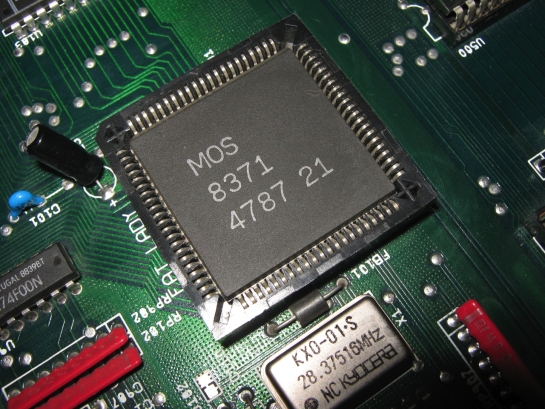
I have decided to upgrade my Amiga 2000 PAL REV 4.5 for get 1MB of chip ram. I also took advantage of this update to install a new battery for the system clock. Amiga 2000 PAL REV 4.5 Fat Agnus 8372A Installation:
- Install a new Fat Agnus 8372A or 8375 (8375 R1)
- Look for jumper J101 beside the power connector to the motherboard. Change it to the opposite position. (photo)
- Look for trace J500 at the back of the machine near the Cia’s (8520′s). It’s a jumper trace that you will have to cut with a razor blade. (photo)
- Look for trace J102 near the Fat Agnus (8372A). It’s a jumper trace that you will have to cut with a razor blade. (photo)
source: amiga-hardware.com amigahardware.mariomisic.de amiga.org
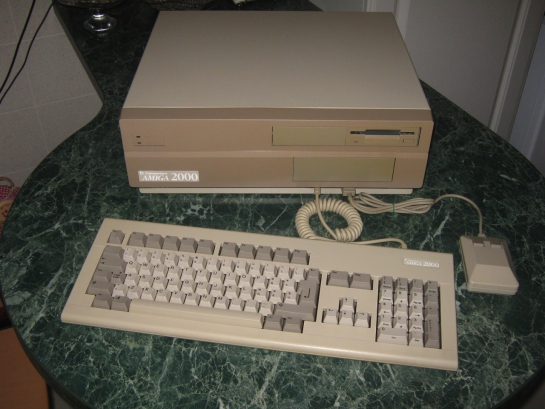
Autopsy:
Today i picked up a Commodore Amiga 2000 (Revision 4.5) in good working condition with Keyboard and Mouse.
I have removed the battery and thoroughly cleaned the PCB in that area. I noticed that the PCB is pretty delicate when trying to unsolder. The solder mask becomes damaged when exposed to too much heat for too long, and probably one would easily kill leads unless being extremely careful. Maybe the board’s age adds to it.
from Wikipedia:
The A2000, also known as the Commodore Amiga 2000, was released in 1986. Although aimed at the high-end market it was technically very similar to the A500, so similar in fact that the A2000B revision was outright based on the A500 design.
What the A2000 had over the A500 was a bigger case with room for five Zorro II proprietary expansion slots, two 16-bit and two 8-bit ISA slots, a CPU upgrade slot, a video slot, and a battery-backed clock.
It should also be noted that, like the Amiga 1000 and unlike the Amiga 500, the A2000 came in a desktop case with a separate keyboard. The case was more PC-like than the A1000 – taller to accommodate the expansion cards and lacking the space beneath for the keyboard.
source: wikipedia
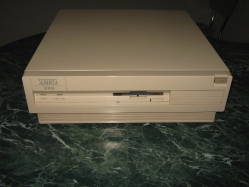
Autopsy:
This is my Commodore Amiga 3000. I used this computer for many years, example: for my BBS “Hidden Power“, coding Amiga / Snes Demos & Trainer and other fun stuff.
I decided to pull out of the box and try if still works, i must say that everything works like 15 years ago (including the Harddisk).
Description:
- Commodore Amiga 3000 rev B2.
- MultiFaceCard III (multi Serial Ports)
- GVP Card with 8 Mb of Fast Memory installed.
- Removed the original Battery.
from Wikipedia:
Released in June 1990, The Commodore Amiga 3000 was the third major release in the Amiga computer family. It revealed a much more focused and sincere attempt to build a high-end professional multimedia computer, boasting improved processing speed, better rendering of graphics, and a revision of the increasingly haggard operating system.
Its predecessors, the Amiga 500,1000 and 2000, shared the same fundamental system architecture and consequently performed without considerable variance in processing speed despite considerable variance in purchase price. The A3000 however, was entirely reworked and rethought as a genuine high-end workstation.
The new Motorola 32-bit 68030 CPU, 68882 math co-processor, and 32-bit system memory helped increase the “integer” processing speed by a factor of 5 to 18, and the “floating point” processing speed by a factor of 7 to 200 times. The new 32-bit Zorro III expansion slots provided for faster and more powerful expansion capabilities.
source: wikipedia
My Amiga with Indivision 1200 now boots directly into 1024×768 32-colors Workbench.
Autopsy:
The IDE-fix adapter doubles the internal IDE port of your A1200. At the same time it’s an adapter from the rather uncommon 2.5 inch standard to the less expensive 3.5 inch standard connections. The first of the two IDE outputs is available as 3.5 inch and 2.5 inch connector, to you can use existing cables.
The IDE-fix adapter is buffered and terminated. That means that your Amiga is shielded from noise that is caused by long cables, so it continues working reliably without crashing.
IDE-fix 97 Key features:
- use cheap Atapi CD-Rom drives.
- use removable IDE/Atapi devices (Syquest, IDE-ZIP, LS120).
- supports TD64-commands – harddisk capacities larger than 4 GBytes possible!
- IDE harddisk autopark.
- Atapi CD-changers (NEC, Sanyo, Torisan) are perfectly supported (CD-change can be done either by a program, or by a separate icon for each inserted CD).
- Cache CD filesystem included!
- CD32 emulator included!
source: vesalia.de
Autopsy:
During the 80s, it was common use to build computers in a way that they can output their picture on a TV set. This was done in order to reduce the overall system cost for the user. TV sets work with lower frequencies compared to today’s monitors, therefore the picture flickers. A flickerfixer (aka de-interlacer) converts the signal in a way that a modern VGA monitor or TFT-display can be used. The name flickerfixer was mainly created because the problem of a flickering picture is solved. Individual Computers already had a very successful product called Indivision in 2002. It was connected to the monitor output of the computer, but it has been sold out since 2006. Indivision AGA‘s most notable features are:
- 24 Bit colour resolution in all screenmodes.
- support for super hires modes.
- Highgfx support up to 1024×768 pixels.
- all screenmodes can be displayed at 60 Hz or more.
- no adjustments necessary.
source: vesalia.de forum
Some pieces recovered from a Amiga 2000 devastated by humidity!





































































































































Recent Comments